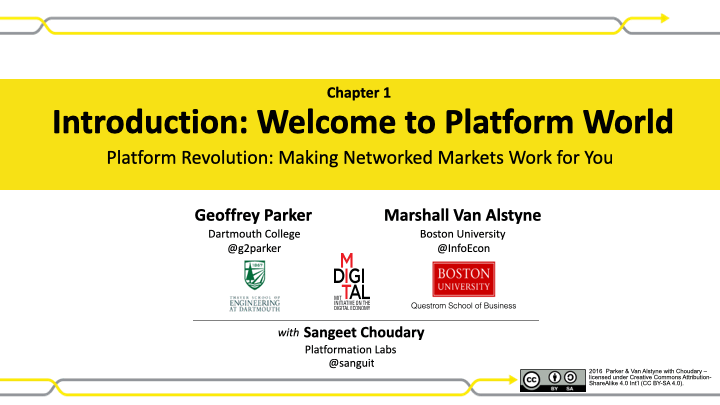UPDATE: In a special interview, information and digital business model expert Professor Marshall Van Alstyne sat down with Step Change to talk about Platform Revolution– the international bestselling guide to the new economy which he co-authored.
Apart from the key concepts of Platform Revolution, Professor Marshall Van Alstyne discusses insights on how to compete with platform businesses, what more information he would add to the current Platform Revolution, the early signs of a successful platform business, and the fate of the massive platforms that are currently dominating the market.
Watch the interview here:
Professor Marshall also shares to the Step Change Community the Chapters 1 to 11 presentation slides from the bestselling guide to the new economy that dives into the success of market disruptors turned industry leaders such as Uber, Airbnb, Amazon, Apple, and PayPal.
Exclusive insights and topics include:
- Introduction: Welcome to Platform World
- Network Effects: The Power of the Platform
- Architecture: Basic Principles for Designing Successful Platforms
- Disruption: How Platforms Conquer &Transform Traditional Industries
- Launch: Chicken or Egg? 8 Ways To Launch Successful Platforms
- Monetization: Capturing the Value Created by Network Effects
- Openness: Defining What Platform Users/Partners Can & Cannot Do
- Governance: Policies That Increase Value and Enhance Growth
- Metrics: How Platform Managers Can Measure What Really Matters
- Strategy: How Platforms Change Competition
- Policy: How Platforms Should (and Should Not) Be Regulated
These are now available for you to download. Get your Platform Revolution Slides here.
Welcome to Knowledge Nuggets, our all new content series where we highlight key takeaways and great business ideas from our favourite books. This week, we will be reviewing the book Platform Revolution by Geoffrey G. Parker, Marshall Van Alstyne, and Sangeet Paul Choudary.
Insight: Today’s industry leading brands are built on platforms, they are disrupting and displacing traditional businesses faster than ever.
Data: Nearly 60% of today’s billion-dollar unicorn startups are platform businesses. (Source)
What’s the step change: Disrupt or be disrupted. Can you recreate your business to respond to platform opportunities and thrive in a platformed world?
The edited transcript:
The Platform Revolution is the backstory to businesses like Airbnb, eBay, Uber, and Facebook. It demonstrates how they have effectively disrupted markets. When people talk about market disruption and technology, they are referring to what is actually a platform business and a platform play.
We will be covering four concepts to understand the distinctions and how they play out for your business.
Businesses which are in the path of disruption are making a choice and need to decide on a strategy according to these three conditions:
- Whether they can transition their existing business model from what used to work in the past to the future
- Whether they could be the disruption and whether that model could work for them
- Whether they find a high value and dependable niche
When it comes to platform revolution and whether it can help your business, here are the four key points you need to consider:
1. Distinguish a Pipeline Business from a Platform Business
In the book, the authors give examples of the way markets are valuing pipeline and platform types of businesses.
A pipeline business is a traditional business where there’s a raw material or resource, a production and manufacture phase, and then finally being delivered to the customer. Each factor and phase is connected and sequential. The business looks to add value at each phase.
The problem is they tend to be linear in growth, you need to add more capacity in terms of production and go-to-market to get a real benefit.
These are physical units and physically restricted.
In contrast, the platform business tends to be a technology based business. The platform seeks to connect many producers with many users. It’s generally a form of online market or interaction.
To distinguish a platform from a pipeline business, they tend to be exponential in nature. To get them up and running, platform businesses can scale up with very small marginal and incremental costs.
2. The Heart of the Platform Business Is Commercialisation of the Core Interaction
You must find what that one core interaction is and how can you commercialise. The types of things that provide commerciality in a platform business are:
- Access is the ability to remove friction and access something easier. Uber did this in the taxi world. From the booking, paying, and tracking process — they removed it and merged payments, avatars, and maps together.
- Marketplace is the ability to bring many different service providers together to provide comparison. In Australia, platforms like iSelect compare the markets that allow people to select, review, and potentially disparate complex products through a filter or platform.
- Tools refer to the ability to get online and into a platform, using tools to create and add value within that marketplace or platform.
- Curation is how you commercialise. You can access content for free like YouTube, but within that, you are subject to advertising. When you commence paying, you get premium content which you can personalise and create your own channels, etc.
Different models exist within the above, however, the answer is finding a core interaction and the commercialisation of that core.
3. Beat the Chicken and the Egg Dilemma
Marketplaces tend to be double-sided. Where there is a producer, there is a user, and markets become valuable when there are lots of both and therefore lots of potential competition.
That’s the Chicken and the Egg Dilemma. Effectively, there are eight different strategies that cover how successful businesses have navigated the Chicken and the Egg Dilemma. Download the Knowledge Nugget PDF below to find out what the eight strategies are.
4. What’s the Nature of the Platform? What Does It Look Like in Your Particular Category or Sector?
Some platforms tend to be winner-take-all. Winner-take-all markets tend to be formed when there’s one business that takes control of the marketplace. If you get the number one position, there will be a huge gap between two, three, or four.
This occurs when there is a scale in supply as the more supplies you have there, the better value there is for users.
With the network effect, the more people within the network, the more valuable it becomes. Facebook is a prime example. If you can find all your friends on Facebook, there is no need to go to other platforms. The network will become more valuable when there are more people on it.
Finally, the platform will benefit from high-switching cost. This means once users have entered their data and decided to use the platform, the cost of switching becomes difficult. These are the topics that are covered in the Platform Revolution.
Download our Knowledge Nugget on the Platform Revolution and the Exclusive Presentation Slides from Professor Marshall here:
















